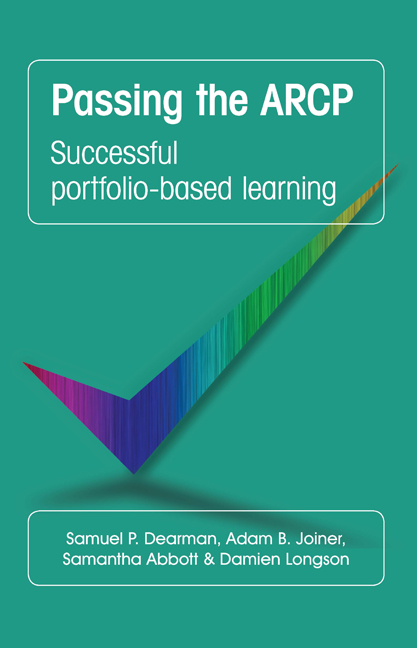Book contents
- Frontmatter
- Contents
- Authors
- List of figures
- Foreword
- Preface
- Acknowledgements
- List of abbreviations
- How to use this guide
- 1 Quick reference guide
- 2 What is a portfolio?
- 3 Lessons learned so far
- 4 Organising the portfolio
- 5 Managing your workplace-based assessments
- 6 Reflective practice and self-appraisal of learning
- 7 Audit and research
- 8 Teaching
- 9 Psychotherapy experience
- 10 Management and leadership experience
- 11 Appraisal reports, planning meetings and educational objectives
- 12 Other experiences, achievements and documents
- 13 The future of portfolios
- Index
12 - Other experiences, achievements and documents
- Frontmatter
- Contents
- Authors
- List of figures
- Foreword
- Preface
- Acknowledgements
- List of abbreviations
- How to use this guide
- 1 Quick reference guide
- 2 What is a portfolio?
- 3 Lessons learned so far
- 4 Organising the portfolio
- 5 Managing your workplace-based assessments
- 6 Reflective practice and self-appraisal of learning
- 7 Audit and research
- 8 Teaching
- 9 Psychotherapy experience
- 10 Management and leadership experience
- 11 Appraisal reports, planning meetings and educational objectives
- 12 Other experiences, achievements and documents
- 13 The future of portfolios
- Index
Summary
An additional, perhaps miscellaneous section, can be useful for experiences, documents or achievements that simply do not fit elsewhere in the portfolio but are of use in contributing towards evidence. The guiding principle here should be why is this in the portfolio and what competency does this relate to? This is an important point and needs emphasis. A degree certificate is certainly an achievement but alone it is not evidence of competence. The list of what could conceivably be included in this section is endless and the following examples are intended as a guide to illustrate how various documents can be used.
Certificates
• Original degree
• Other degree certificates
• GMC certificate
• Disclosure and Barring Service clearance
• Intermediate and basic life support
• Breakaway techniques certificate
• MRCPsych exams (some people give number of attempts)
Although these may not relate directly to specific competencies, they do say something about level of seniority and staying up to date. If any of these are related to competency, a word about their content should be given. For example, if it is a certificate concerning an examined course, a brief note about the content of the course, the skills involved, key learning points, reflective notes and the fact of the examination should be added. This should then be indexed in the summary of evidence section, especially if it involves any directly observed skills in practice. As most training schemes and NHS trusts require annual breakaway and cardiopulmonary resuscitation training, why not also use these to complete a DOPS (Direct Observation of Procedural Skills) WPBA?
Your curriculum vitae
The curriculum vitae (CV) may appear slightly outdated now with the electronic application system for jobs and the existence of the portfolio itself. The CV can be useful if it can be structured with competencies in mind. It can further be used as a bank for achievements you may have that do not fit well into the portfolio. It should be remembered that the portfolio contains evidence of competence, so unsubstantiated claims are not helpful. Therefore, and for example, a section of the CV concerning awards with a list of prizes for clinical excellence only becomes evidence when accompanied with the supporting documentation.
- Type
- Chapter
- Information
- Passing the ARCPSuccessful Portfolio-Based Learning, pp. 58 - 60Publisher: Royal College of PsychiatristsFirst published in: 2017

